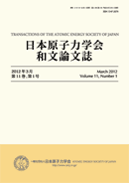Volume 15, Issue 2
Displaying 1-6 of 6 articles from this issue
- |<
- <
- 1
- >
- >|
Fukushima NPP Accident Related
Article (Fukushima NPP Accident Related)
-
2016Volume 15Issue 2 Pages 53-65
Published: 2016
Released on J-STAGE: May 15, 2016
Advance online publication: March 15, 2016Download PDF (10562K)
Rapid Communication
-
2016Volume 15Issue 2 Pages 66-69
Published: 2016
Released on J-STAGE: May 15, 2016
Advance online publication: March 18, 2016Download PDF (3639K)
Article
-
2016Volume 15Issue 2 Pages 70-83
Published: 2016
Released on J-STAGE: May 15, 2016
Advance online publication: April 20, 2016Download PDF (3117K) -
2016Volume 15Issue 2 Pages 84-96
Published: 2016
Released on J-STAGE: May 15, 2016
Advance online publication: April 20, 2016Download PDF (3783K) -
2015Volume 15Issue 2 Pages 97-114
Published: 2015
Released on J-STAGE: May 15, 2016
Advance online publication: April 28, 2016Download PDF (6970K) -
2016Volume 15Issue 2 Pages 115-127
Published: 2016
Released on J-STAGE: May 15, 2016
Advance online publication: April 26, 2016Download PDF (1975K)
- |<
- <
- 1
- >
- >|
